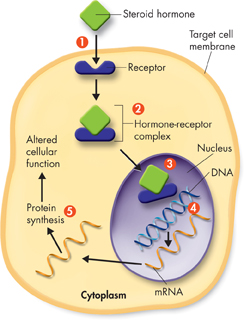Prostaglandins The glands of the endocrine system were once thought to be the only organs that produced hormones. However, nearly all cells have been shown to produce small amounts of hormonelike substances called prostaglandins (prahs tuh GLAN dinz). Prostaglandins are modified fatty acids that are produced by a wide range of cells. They generally affect only nearby cells and tissues, and thus are sometimes known as “local hormones.”
Some prostaglandins cause smooth muscles, such as those in the uterus, bronchioles, and blood vessels, to contract. One group of prostaglandins causes the sensation of pain during most headaches. Aspirin helps to stop the pain of a headache because it inhibits the synthesis of these prostaglandins.
BUILD Vocabulary
WORD ORIGINS Prostaglandins get their name from a gland in the male reproductive system, the prostate, in which they were first discovered.
Hormone Action
 How do hormones affect cells?
How do hormones affect cells?
Hormones fall into two general groups—steroid hormones and nonsteroid hormones. Steroid hormones are produced from a lipid called cholesterol. Nonsteroid hormones include proteins, small peptides, and modified amino acids. Each type of hormone acts on a target cell in a different way.
Steroid Hormones Because steroid hormones are lipids, they can easily cross cell membranes.  Once in the cell, steroid hormones can enter the nucleus and change the pattern of gene expression in a target cell. The ability to alter gene expression makes the effects of many steroid hormones especially powerful and long lasting. Figure 34–2 shows the action of steroid hormones in cells.
Once in the cell, steroid hormones can enter the nucleus and change the pattern of gene expression in a target cell. The ability to alter gene expression makes the effects of many steroid hormones especially powerful and long lasting. Figure 34–2 shows the action of steroid hormones in cells.

FIGURE 34–2 Steroid Hormones Steroid hormones act by entering the nucleus of a cell and changing the pattern of gene expression.
d1 A steroid hormone enters a cell by passing directly across the cell membrane.
2 Once inside, the hormone binds to a receptor (found only in the hormone's target cells) and forms a hormone-receptor complex.
3 The hormone-receptor complex enters the nucleus of the cell, where it binds to regions of DNA that control gene expression.
4 This binding initiates the transcription of specific genes to messenger RNA (mRNA).
5 The mRNA moves into the cytoplasm and directs protein synthesis.
Hormone-receptor complexes work as regulators of gene expression—they can turn on or turn off whole sets of genes. Because steroid hormones affect gene expression directly, they can produce dramatic changes in the activity of a cell or organism.
Table of Contents
- Formulas and Equations
- Applying Formulas and Equations
- Mean, Median, and Mode
- Estimation
- Using Measurements in Calculations
- Effects of Measurement Errors
- Accuracy
- Precision
- Comparing Accuracy and Precision
- Significant Figures
- Calculating With Significant Figures
- Scientific Notation
- Calculating With Scientific Notation
- Dimensional Analysis
- Applying Dimensional Analysis




